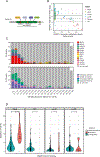A mutational signature reveals alterations underlying deficient homologous recombination repair in breast cancer
- PMID: 28825726
- PMCID: PMC7376751
- DOI: 10.1038/ng.3934
A mutational signature reveals alterations underlying deficient homologous recombination repair in breast cancer
Abstract
Biallelic inactivation of BRCA1 or BRCA2 is associated with a pattern of genome-wide mutations known as signature 3. By analyzing ∼1,000 breast cancer samples, we confirmed this association and established that germline nonsense and frameshift variants in PALB2, but not in ATM or CHEK2, can also give rise to the same signature. We were able to accurately classify missense BRCA1 or BRCA2 variants known to impair homologous recombination (HR) on the basis of this signature. Finally, we show that epigenetic silencing of RAD51C and BRCA1 by promoter methylation is strongly associated with signature 3 and, in our data set, was highly enriched in basal-like breast cancers in young individuals of African descent.
Figures







References
MeSH terms
Substances
Grants and funding
LinkOut - more resources
Full Text Sources
Other Literature Sources
Medical
Research Materials
Miscellaneous

